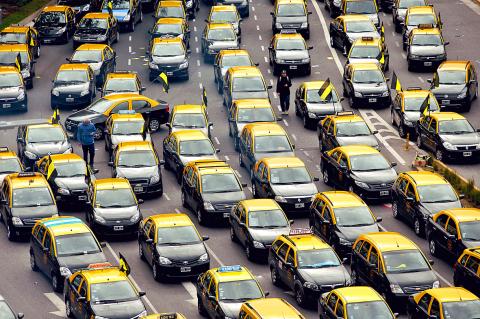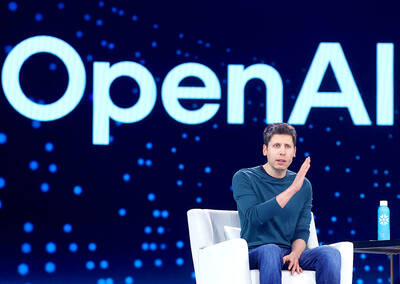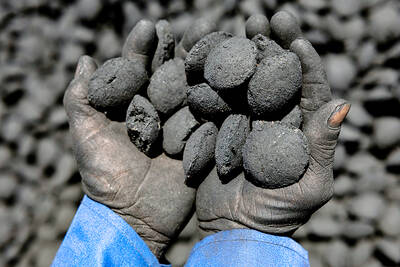Auto giants are racing to invest in car and ride-sharing services, lured by the prospect of fat profits yet to be tapped from a billion cars on the world’s roads.
A typical car spends 95 percent of its life at a standstill, industry analysts say, making it a vastly under-utilized, depreciating asset. There might be big money waiting, therefore, for the business that can get the car moving again.
That is incentive enough for manufacturers from Toyota to Volkswagen and General Motors (GM) to join an investment rush, apparently without fear of ushering in a future in which individual car ownership is no longer king.

Photo: AP
Thinking of the car business as a service dramatically changes perceptions of its value, Morgan Stanley analyst Laura Lembke told a conference in Munich, Germany, last week.
New car sales worldwide run at about 80 million a year bringing in US$1.5 trillion, Lembke said.
However, the total existing stock of cars is closer to 1 billion vehicles. If the average cost of a trip is US$0.63 per kilometer, she estimated the market value could be as much as US$10 trillion.
That estimate helps to explain the valuations placed on apps such as ride-hailing service Uber, valued at US$62.5 billion — a third more than the world’s No. 3 auto manufacturer GM.
GM this year invested US$500 million in Lyft, one of the chief competitors to Uber in the US.
Last month, Toyota announced a strategic partnership with Uber, with an undisclosed investment. Volkswagen ploughed US$300 million euros into taxi app Gett on the same day.
“Alongside our pioneering role in the automotive business, we aim to become a world leading mobility provider by 2025,” Volkswagen chief executive Matthias Mueller said.
Automakers see an opportunity, but it is too early to accurately assess the potential value of such a young industry, said Jeremy Carlson, senior analyst of automotive technology at research group IHS.
Car manufacturers might sell into a fleet of vehicles for drivers to use in these new services, he said. Or they might decide to gain experience and launch competing services.
“Yes, this has the potential and the likelihood to impact the traditional automotive business model at least in some capacity,” Carlson said.
“But we don’t expect the kind of traditional ownership and sales model to disappear anytime soon. We expect it to be the majority until at least 2035 and for all of those years vehicle sales, the traditional model, remains the vast majority of our automotive sales,” he added.
Even if the future brings us self-driving vehicles combined with car-hailing apps to offer a service rivaling the convenience of private ownership, the market for car manufacturers could survive, the analyst said.
“When you have autonomous added to car sharing and ride sharing, those vehicles are running at a higher rate and are making many more trips. The idea is that you will replace those vehicles much faster,” Carlson said. “There may be an impact on the total vehicle production and sales base, but it’s certainly not nearly as drastic as we have seen in other reports.”
Paulin Dementhon, founder of Drivy, a French app that lets car owners rent out their vehicles, said the new services were starting to live up to their promise.
Manufacturers, now concerned primarily with building and selling vehicles, would have to decide how to adapt to a market of car-related services, he said.
“Sales might suffer a bit, but the car is also a consumable,” Dementhon said. “There will be fewer people buying cars, but after two years they will have done 200,000km.” Then they will need replacing.

DIVIDED VIEWS: Although the Fed agreed on holding rates steady, some officials see no rate cuts for this year, while 10 policymakers foresee two or more cuts There are a lot of unknowns about the outlook for the economy and interest rates, but US Federal Reserve Chair Jerome Powell signaled at least one thing seems certain: Higher prices are coming. Fed policymakers voted unanimously to hold interest rates steady at a range of 4.25 percent to 4.50 percent for a fourth straight meeting on Wednesday, as they await clarity on whether tariffs would leave a one-time or more lasting mark on inflation. Powell said it is still unclear how much of the bill would fall on the shoulders of consumers, but he expects to learn more about tariffs

NOT JUSTIFIED: The bank’s governor said there would only be a rate cut if inflation falls below 1.5% and economic conditions deteriorate, which have not been detected The central bank yesterday kept its key interest rates unchanged for a fifth consecutive quarter, aligning with market expectations, while slightly lowering its inflation outlook amid signs of cooling price pressures. The move came after the US Federal Reserve held rates steady overnight, despite pressure from US President Donald Trump to cut borrowing costs. Central bank board members unanimously voted to maintain the discount rate at 2 percent, the secured loan rate at 2.375 percent and the overnight lending rate at 4.25 percent. “We consider the policy decision appropriate, although it suggests tightening leaning after factoring in slackening inflation and stable GDP growth,”

Meta Platforms Inc offered US$100 million bonuses to OpenAI employees in an unsuccessful bid to poach the ChatGPT maker’s talent and strengthen its own generative artificial intelligence (AI) teams, OpenAI CEO Sam Altman has said. Facebook’s parent company — a competitor of OpenAI — also offered “giant” annual salaries exceeding US$100 million to OpenAI staffers, Altman said in an interview on the Uncapped with Jack Altman podcast released on Tuesday. “It is crazy,” Sam Altman told his brother Jack in the interview. “I’m really happy that at least so far none of our best people have decided to take them

As they zigzagged from one machine to another in the searing African sun, the workers were covered in black soot. However, the charcoal they were making is known as “green,” and backers hope it can save impoverished Chad from rampant deforestation. Chad, a vast, landlocked country of 19 million people perched at the crossroads of north and central Africa, is steadily turning to desert. It has lost more than 90 percent of its forest cover since the 1970s, hit by climate change and overexploitation of trees for household uses such as cooking, officials say. “Green charcoal” aims to protect what